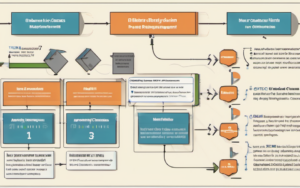The explosive growth of blockchain technology is reshaping industries and challenging traditional models. Understanding this evolution requires a deep dive into the data, examining everything from market capitalization to regulatory landscapes. This statistical overview aims to provide a comprehensive picture of blockchain growth, offering insights into its current state and potential future trajectory.
1. Introduction
1.1 The Rise of Blockchain Technology
Blockchain’s rise has been nothing short of phenomenal. Initially known primarily for its association with cryptocurrencies like Bitcoin, its potential applications have far surpassed these early beginnings. The underlying technology, a decentralized, immutable ledger, is revolutionizing sectors from finance to healthcare, driving significant innovation and disrupting established norms. This fundamental shift has fueled considerable interest and investment, leading to a rapidly expanding ecosystem.
1.2 Scope of this Statistical Overview
This overview will analyze key indicators reflecting blockchain growth, providing a balanced perspective. We’ll examine market capitalization trends, exploring the performance of Bitcoin and altcoins, and assessing overall market volatility. Further, we’ll delve into the adoption rates across various industries, highlighting successful implementations and analyzing current blockchain usage statistics by industry. The analysis will also consider developer activity and ecosystem growth, regulatory developments, and finally, projections for the future.
2. Market Capitalization and Cryptocurrency Trends
2.1 Overall Market Growth
The overall cryptocurrency market has experienced periods of explosive growth, interspersed with significant corrections. Analyzing historical data reveals exponential growth in certain periods, while others show periods of consolidation. Understanding these cycles is crucial for investors and businesses exploring the potential of cryptocurrencies. Tracking the overall market capitalization provides a valuable benchmark for assessing blockchain growth as a whole. Reliable sources for these statistics include CoinMarketCap and CoinGecko.
2.2 Bitcoin Dominance
Bitcoin, the first and most well-known cryptocurrency, maintains a significant share of the overall market capitalization. However, the proportion of the market held by Bitcoin (often termed “Bitcoin dominance”) has fluctuated significantly over time. The rise and fall of Bitcoin dominance offers valuable insights into investor sentiment and the adoption of altcoins. Analyzing this trend helps paint a complete picture of blockchain market diversification.
2.3 Altcoin Performance and Trends
The performance of altcoins (alternative cryptocurrencies) has been highly diverse. Some have demonstrated impressive growth potential, outperforming Bitcoin in certain periods. Others have faded into obscurity. This variability underscores the inherent risk and the need for careful due diligence when investing in alternative cryptocurrencies. Analyzing individual altcoin performance provides a nuanced understanding of the broader blockchain growth landscape.
2.4 Market Volatility and Risk Assessment
The cryptocurrency market is known for its volatility. Price fluctuations can be extreme, presenting both significant opportunities and substantial risks. Understanding these fluctuations and the factors driving them is critical for informed decision-making. Proper risk assessment tools and diversification strategies are essential for navigating this dynamic market. A thorough understanding of blockchain market size growth forecast is also essential for navigating this volatile environment.
3. Blockchain Adoption Across Industries
3.1 Financial Services
3.1.1 Decentralized Finance (DeFi)
The rise of Decentralized Finance (DeFi) is a significant driver of blockchain adoption. DeFi protocols offer alternative financial services, bypassing traditional intermediaries. The growth of DeFi has been remarkable, with increasing numbers of users and total value locked (TVL) in various protocols.
3.1.2 Cross-border Payments
Blockchain technology offers the potential to streamline cross-border payments, reducing costs and processing times. Several platforms are leveraging blockchain to facilitate faster and more efficient international transactions. This is leading to increased adoption within the financial services sector.
3.2 Supply Chain Management
3.2.1 Tracking and Traceability
Blockchain’s ability to provide immutable records enhances tracking and traceability within supply chains. This is particularly beneficial for industries dealing with perishable goods or those requiring stringent quality control. Improved transparency can enhance trust and efficiency.
3.2.2 Enhanced Security and Transparency
Blockchain’s secure and transparent nature helps mitigate risks associated with supply chain fraud or counterfeiting. The ability to track products from origin to consumer enhances accountability and builds greater confidence. These benefits are driving increased adoption across diverse industries.
3.3 Healthcare
3.3.1 Data Security and Privacy
Blockchain technology offers improved data security and privacy in healthcare. The decentralized and encrypted nature of blockchain makes it difficult for unauthorized access to sensitive patient data. This addresses a critical concern within the healthcare sector.
3.3.2 Interoperability and Data Sharing
Blockchain can facilitate interoperability and data sharing within the healthcare ecosystem. Securely sharing patient records across different healthcare providers can improve patient care and streamline administrative processes. This is crucial for improving the efficiency and coordination of healthcare services.
3.4 Other Industries (e.g., Voting, Gaming, etc.)
The applications of blockchain extend beyond finance, supply chain, and healthcare. Industries like voting, gaming, and digital identity management are exploring the potential of blockchain to enhance security, transparency, and efficiency. The diverse applications showcase the versatility and scalability of the technology. Global blockchain implementation statistics 2023 highlight the expanding adoption across these various sectors.
4. Developer Activity and Ecosystem Growth
4.1 Number of Active Developers
The number of active blockchain developers is a key indicator of ecosystem growth. A vibrant developer community is essential for innovation and the creation of new applications. Tracking the growth of this community provides insights into the future trajectory of blockchain technology.
4.2 Development of New Tools and Platforms
The development of new tools and platforms is fueling blockchain growth. Improved development environments, frameworks, and libraries are making it easier for developers to build and deploy blockchain applications. This accessibility is driving increased participation and innovation within the ecosystem.
4.3 Community Engagement and Support
A strong community fosters collaboration and knowledge sharing, crucial for the long-term success of blockchain technology. Active forums, online communities, and educational resources are vital for attracting and retaining developers. This communal aspect fuels ongoing development and improvement.
5. Regulatory Landscape and Future Outlook
5.1 Global Regulatory Trends
Regulatory frameworks governing blockchain technology are still evolving globally. Different jurisdictions have adopted diverse approaches, ranging from highly restrictive to supportive policies. Understanding these regulatory trends is crucial for businesses operating in the blockchain space. A clear understanding of blockchain technology growth statistics helps to inform regulatory strategies.
5.2 Impact of Regulations on Blockchain Adoption
Regulatory clarity can significantly impact blockchain adoption. Well-defined regulations can foster trust and reduce uncertainty, encouraging greater investment and innovation. Conversely, overly restrictive regulations can stifle growth and hinder the development of the industry.
5.3 Future Predictions and Potential Challenges
The future of blockchain technology holds both immense potential and significant challenges. Technological advancements, regulatory developments, and market forces will continue to shape its trajectory. Addressing scalability issues, improving interoperability, and fostering greater user adoption remain key priorities for the industry. Statistical analysis blockchain adoption rate provides invaluable insights for future predictions. Considering current blockchain usage statistics by industry helps assess the future potential for growth.
The future of blockchain is dynamic and depends on a multitude of factors. However, the current trends, especially the increasing adoption across various sectors and the continued growth of the developer community, point towards a significant role for blockchain technology in shaping the future of various industries. Continued monitoring of blockchain technology growth statistics will be crucial to understanding this ongoing evolution.




